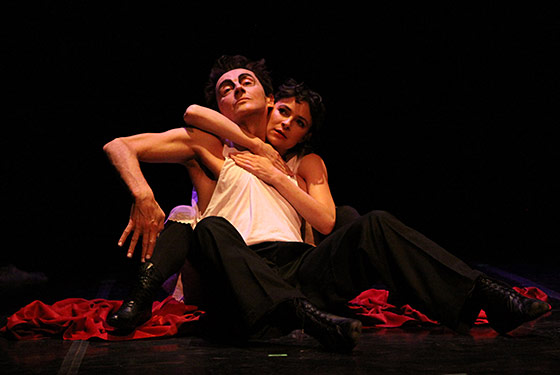
About a quarter-century ago, the unclassifiable performance artist John Kelly—trained dancer, untrained singer, an exuberant collagist but a scrupulous avoider of camp—debuted a nearly wordless multimedia show based on the life and art of the pioneering Expressionist painter Egon Schiele. He’s performing it again, for the final time, and I’d recommend you take a look, even if the title sounds like a joke to you, an Onion-headline version of performance art at its most obtuse. (Confession: In my ignorance, I had a good long laugh when the invitation arrived in my inbox. Meat plus performance art equals easy punchline!) But Kelly, now in his fifties, is an honest and hypertalented stage artist, a conceptualist who doesn’t over-rely on concept, and though his show appears largely unchanged (based on what I’ve read about the original), I suspect the additional years have added some intriguing new crinkles to this portrait of an artist who died a very young man.
Schiele’s chief subject was flesh, vital and intrinsically libidinous, yet also ineluctably decaying and decayed. His paintings were frightening by the ruddy-cheeked standards of Art Nouveau, pugnaciously unpretty, even clammy, but pulsing with sensual energy. Unlike his mentor, Klimt, Schiele’s interest was not in some sumptuous erotic fever dream, but in the more pungent, primal, Freudian tension between sex and death. Plus: nobody in Vienna drew pubic hair better. (He was briefly jailed as a pornographer by Austrian authorities in 1912.) Kelly’s metier, on the other hand, is motion. Inspired by the contorted bodies of Schiele’s drawings and paintings—young people, mostly young women, in jutted, lustful poses, rendered in gashed black lines with only the stingiest kisses of color—Kelly responds not by merely aping art but passionately conversing with it. The scenes and dances are, for the most part, not recreations of Schiele paintings, but dramatic pantomimes of the Schiele ethos: Wry, gothic, lust-bitten, and delighted with its own transgressions. There’s no nudity, and not even a lot of posing, but rest assured, this is a very sexy show, thanks in no small part to the carefully modulated sensuality of Tymberly Canale and Mackenzie Meehan, who play Schiele’s model/lover Valerie “Wally” Neuzil and his wife Edith Harms, respectively.
But those passions are nothing compared to ecstatically masturbatory self-love of the artist. (Do I mean Kelly or Schiele? To Kelly’s credit, they’re tough to parse.) To say Kelly disappears inside the character is tempting, but inaccurate. True, he’s made himself up to look remarkably like Schiele (or, more accurate, one of Schiele’s famous self-portraits): pallid, elfin, sporting an alarmed Eraserhead goth-shock of witchy black hair. Kelly seems perfectly aware that he’s sourcing an impression from a series of paintings, and carries a distinct but nonironic sense of that self-knowledge into every scene: He brings in hints of Chaplin and Groucho, and, with a wink to Schiele’s coeval, Freud, splits himself in three when he’s fully and rapturously engaged in the creation of art. (Luke Murphy and Eric Jackson Bradley dance the other two Schiele-shards with a ballsy athleticism that’s just shy of fratty.) This Schiele is a walking illustration of himself, and Kelly gracefully underlines this with a pair of Murnau-inflected short-films that bookend the performance: He’s shown drawing a Schiele self-portrait on the camera lens, superimposing it over his own filmed image, hemming himself in. In the first, he’s creating himself—in the last, entombing himself—in someone else’s art.
Blutwurst is Kelly’s own art, of course, perhaps his signature work. But now that he’s older, that sense of entombment feels a little more immediate. We watch Schiele unlock his creativity (to the heroic strains of Giselle), fall in love twice, defy authority, succumb to norms, triumph as an artist, and finally fall to the Spanish flu that claimed him, his wife and his muse, all within a year of one another, all before any of them were 30—all so quickly, so ecstatically, it takes our breath away. With a man in his fifties dancing the lead (brilliantly and weightlessly), what’s added is the gentlest suggestion of tragic buffoonery (I mean that in the best way!), an acknowledgment of the inborn tendency in every man (young or old, artist or not) to experience all stages of his life simultaneously. If he possess a still-liquid life-force and half-functioning plumbing, he is both young comer and old soul at every moment of his existence, and this makes him semi-ridiculous and half-heroic all at once. This feels, to me, like Kelly’s theme, like what he’s united in Schiele. With pathos and humor, he pulls off a great theatrical ravishment, apparently for the last time. It’s worth taking in before he seals the tomb.
At La MaMa’s Ellen Stewart Theatre through December 19.




